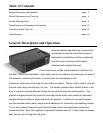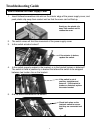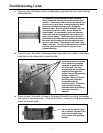
c. Check to see if the blower wheel is adequately supported by the outside bearing
plate assembly.
d. Check to see if the motor mounting bracket snap tabs are in place or are loose.
Look into the four base slots to see the tabs.
e. Check to see if the motor is loose in the support bracket by holding the bracket
and trying to move the motor. If the motor moves, remove the mounting bracket to
check the isolator pads
11
Troubleshooting Guide
If the tabs are not in position,
use a screwdriver inserted
into slots to push the tabs
out of the slot. You may
need to twist the screwdriver
slightly to disengage the
snaps. Inspect the mounting
bracket; replace it if
damaged. Check for broken
mounting tabs, distorted
bracket (because of
excessive heat). A distorted
motor bracket normally
indicates motor overheating.
The motor should be
replaced.
Insure that the isolator pads
are in position. Replace if the
motor moved while being
held in place with mounting
bracket.
The outboard end of the blower wheel should be
firmly supported, allowing no
movement other than
rotation. If that end of the wheel can be moved front
to back and up and down, remove the bearing plate
assembly and check the bearing for damage or
excessive wear. Replace parts as needed. Use care
in handling the blower wheel. Do not distort the
wheel blades. On reassembly, insert the outboard
wheel shaft into the bearing plate then position the
plate into the cabinet. The blower wheel should be
positioned so that the clearance between the ends of
the wheel and the adjacent walls are approximately
equal on both sides. If the wheel is too close it may
drag on the wall. Too much clearance at the outboard
end may cause the wheel shaft to slip out of the
outboard bearing.


















